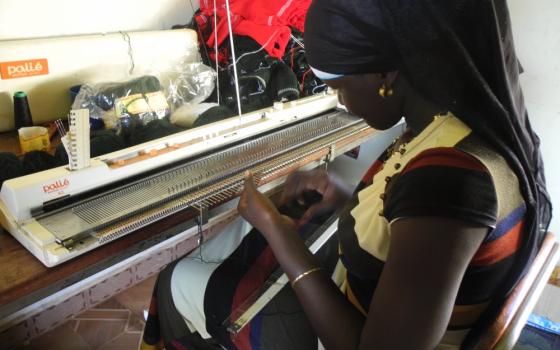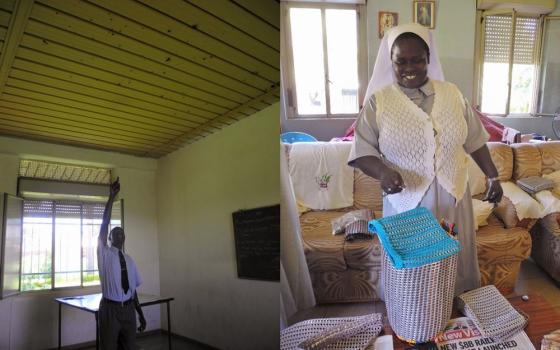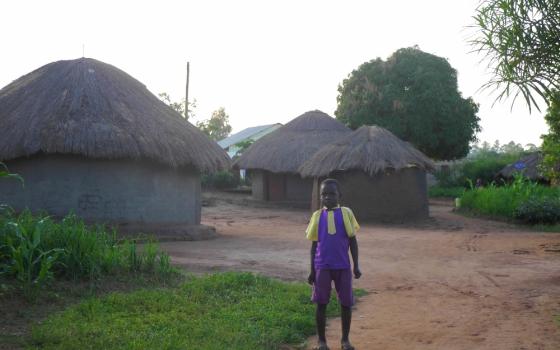Editor's note: This is Part One of a two-part look at healing in Uganda. Read Part Two.
Northern Uganda is shattered. After decades of civil war and rebel insurgencies led by Joseph Kony and the Lord’s Resistance Army (LRA), the northern part of the country is just beginning to emerge from their struggle for survival and take stock of their enormous losses. According to a United Nations report, the LRA kidnapped up to 100,000 children and brainwashed them to stay in bush camps during Kony’s reign of terror, which started in 1987.
Everyone in northern Uganda agrees that these children, who were snatched from their homes, are victims of this conflict. But these children are also the soldiers who perpetrated horrific atrocities, at times storming villages and killing hundreds of people, raping women and girls, burning down entire towns.
With international pressure, including a warrant from the International Criminal Court in 2005 and peace negotiations attempts with the government in 2008, Kony has withdrawn from northern Uganda and is now in hiding in the Central African Republic, Sudan or the Democratic Republic of Congo.
And as the children of northern Uganda emerged from the bush and tried to come home, the scarred communities they left struggled to absorb them. The children’s presence is a reminder of the things that they did and people they killed, a reminder of impossible loss. But at the same time, the community cannot reject an entire generation of children.
Sr. Pauline Acayo, a Little Sister of Mary Immaculate of Gulu, was the director of Catholic Relief Services in northern Uganda for 14 years before moving to another post with CRS. She calls these children “returnees.”
“Returnees” is a purposefully neutral term. Terms like “ex-soldier” stigmatize the children, tying them to identity they want to forget, while calling them “victims” ignores the pain of the communities.
Africa is no stranger to war and conflict. So when community leaders wanted to foster a sense of closure and moving forward, they reached back to their roots, to traditional African ceremonies dealing with murder and war. Religious leaders, who are at the forefront of reconciliation efforts, embraced the idea.
“The cultural justice system brings people together unlike the Western court system, which only brings polarization,” explained Rev. Macleord Baker Ochola II, an Anglican bishop and one of the founders of the Acholi Religious Leaders Peace Initiative (ARLPI). “There, the victim and the perpetrator are pushed far away from each other. Here, they are pushed together.
“We show that you are me, that you are a human being, that you cannot do this again. Cultural justice is not imposed on people . . . . In these days with guns and bullets, it’s impossible to know who killed someone. But if a person accepts responsibility, it’s very effective because you didn’t impose it. If you kill and don’t accept responsibility, the tribes will fight. But in our culture once someone confesses, you have no option except to forgive.”
Acholi is the dominant tribe in northern Uganda, part of the Luo-speaking people that encompasses tribes in Uganda, Sudan and Kenya, including Barack Obama’s father. The Acholi have a wealth of traditions and ceremonies dealing with forgiveness.
There’s the concept of chuluquwe, of paying for damage you have caused, followed by reconciliation. There’s the mato oput ceremony, named for a tree that grows with two trunks but one root, for when one tribe member has murdered another tribe member. There’s also nyonatongwheno, a ceremony of stepping on an egg to symbolize the recognition of the purity of human life.
When there’s been a murder, a murderer cannot return home with blood on his or her hands, Ochola explained. The murderer must wait at the gate and give testimony, after which it becomes “community-based collective responsibility,” Ochola said.
When one person murders another person, tribes engage in the mato oput ceremony. This requires years-long arbitration by a third tribe to determine compensation and a final ceremony where female relatives from the two sides drink the bitter tree root from a calabash gourd with their foreheads touching. But this ceremony is only for a single murder. Traditional Acholi practices did not have a precedent for the mass killings of the LRA.
“The LRA has no comparison in the past, this is a completely new situation,” said Ochola, who lost his wife and a daughter to atrocities. “An abduction is tantamount to murder. The enslavement of a girl child as a sex slave is like murder.” Uganda’s web of victims and perpetrators was too tangled for this single ceremony.
But Acayo, the sister working with CRS, recognized that the traditional ceremony needed to be included in a public forum as part of the healing process.
The process started as returnees coming out of the bush were brought to temporary reception centers run by organizations like World Vision and GUSCO (Gulu Support the Children Organization). “I'd have to prepare the community, talking about acceptance then organizing a way to reconcile publically with these children,” she said. “Only then we could begin reintegrating them into the community.” Acayo worked together to create reconciliation ceremonies with ARLPI, the Catholic Church’s Justice and Peace Commission, Caritas International, People’s Voice for Peace and village chiefs.
While the children were in the reception centers re-acclimating to life outside of the bush, leaders worked with the community. “I trained them using the Ugandan constitution translated into local language, and we developed peace-building training manuals, which entailed things like mediation, acceptance, and dialogue,” Acayo explained.
“Then we set a day for reconciliation, a day people came out in great number,” Acayo said. “On one day we would reconcile 800 kids, and we were doing this almost every two weeks. We were using the traditional Acholi reconciliation with an egg [symbolizing purity of life]. They also jump over a reed that is very slippery; this symbolizes being washed from the atrocities, the killing, the burning of houses, whatever you've done to the communities.
“We also had a pole that they use for opening a granary; this symbolizes that today you are welcome to the community, you'll not only be fed by your family but by everyone in the community. After that they go and sit with the community. The Acholi religious leaders lead prayers after the ceremony. We have an archbishop and the khadi [Muslim leader] and Protestant leaders and others.
“After the prayer, we gave the community a chance to ask for forgiveness, and the returnees ask for forgiveness also,” she continued. “Then the community embraces them. In our culture when food is put on the ground and we eat together, it's a sign of unity.”
Acayo noted that the balance between traditional ceremonies and religious prayer, from all religious leaders, helped the reconciliation appeal to both aspects of the community’s identity. Acayo helped organize reconciliation ceremonies for more than 5,000 returnees, earning her a slew of awards, including Woman Peacemaker of the Year from San Diego University, a Beacon of Peace from CRS, and an Outstanding Leadership Award from the Association for Conflict Resolution.
The reconciliation ceremony is important, but it does not heal every wound. “These returnees, they were forced to come and kill their own family members, and sometimes people in the community are still reacting,” Acayo said. “They say, ‘You killed my mother and father, how can you come back to the community?’ So we have to continue sensitizing that community.”
There was also pushback from some religious leaders over the use of traditional ceremonies. “Some Christians believe that [these ceremonies] are not a Christian thing to do,” said Ochola, the archbishop with ARLPI. “But our culture is more Christian than anything. This ceremony is not done by a witch doctor, it’s done by the community.”
Ochola said some people were also surprised by ARLPI’s cooperation between all religions, including Catholic, Anglican, Muslim, Orthodox Christian, Evangelical, Pentecostal and Seventh-day Adventist. Uganda is about 12 percent Muslim, 40 percent Catholic, and 40 percent Protestant, according to the CIA World Factbook. “Some Christians were taken aback, and asked, ‘Why should we pray with Muslims? We can understand uniting between Catholics and Anglicans, because both are Christian, but Muslim?’”
ARLPI started in 1997 in response to the LRA massacres of 400 people in Kitgum. Kony is from the Acholi tribe, and residents of Kitgum wanted to start killing all Acholi members. Additionally, Kony’s claims that he was spiritually anointed to lead the LRA confused some people into thinking Kony was connected to the church. The religious leaders had been trying separately to plead tolerance and understanding in their congregations, but they were losing the fight. “Then we said, ‘Why can’t we speak with one voice? The people being affected are all our flock,’” Ochola said.
“Because of our consistency and credibility, the government, the LRA, and the international community have trust in us [religious leaders],” said Ochola. “We were not bending to the role of the LRA or the government; we were completely impartial in the middle, trying to protect our people.”
“The rebels were much more responsive to neutral organizations that looked towards bringing peace, because they weren’t acting in a harmful way,” explained Charles Opira, an administrator and counselor at the St. Monica Girls Tailoring School.
St. Monica hosted peace talks between the LRA and the Ugandan government, and also served as a destination for hundreds of children looking for protection. There are still bullet holes strafed across a classroom ceiling from LRA soldiers who broke into the compound trying to abduct children. In April, TIME magazine named St. Monica’s director, Sr. Rosemary Nyirumbe, one of the 100 most influential people of 2014, and she was featured in the documentary “Sewing Hope,” narrated by Forest Whitaker.
Female returnees faced special challenges, because many returned from the bush with children from Kony’s soldiers, and they had no education because they were kidnapped in the middle of their schooling. “When these girls came, they didn’t have anything,” said Opira. “They were even rejected by their own parents . . . . The stigmatization caused worse problems than being in the bush.”
St. Monica offered vocational training, counseling and a place to live as the female returnees struggled as single mothers. “Most of the girls were soldiers, some were even commanders,” said Sr. Poline Ochida, of the Sacred Heart of Jesus, who is the head teacher of the kindergarten at the center. “In the beginning, it was not easy to reach them. Other girls could provoke them, pick a quarrel, by pointing out things that are very delicate about their past . . . . They felt out of place. They did such terrible things to their communities.”
Religious leaders still have a long journey towards healing their communities from such deep trauma. But they continue using the lessons learned from the aftermath of the war with the LRA, including how to blend traditional and religious practices to solve conflicts.
Today, since the majority of the children have returned, Acayo and Ochola are using this combination of religion and tradition to resolve land disputes. Land ownership is deeply connected to tribal conflicts and identity, but ownership was thrown into disarray during the war years. In many cases, boundaries were delineated by things like a large tree, which could have been destroyed during the war.
But rather than costly court battles that thrust farmers even deeper into poverty and take years to resolve, Acayo and Ochola are promoting mediation, where both sides talk with a local religious leader for four or five meetings and then end with a traditional land ownership ceremony and shared meal. Acayo and the organizations she works with have overseen more than 3,000 land mediations in the past five years.
Ochola believes that Ugandans will emerge from the tragedy of their latest war stronger and more resilient, despite the deep wounds. He likes to tell a traditional story, the story of two Acholi brothers who got into a terrible argument, a bitter dispute that lead to the murder of one of their daughters.
The brothers were so enraged they decided never to talk to each other again, and they did a ceremony to nullify their family ties. They stood back to back in the Nile River that runs through northern Uganda and marched away from each other angrily, without once looking back, representing a severance in their family tree. But the village elders said it didn’t matter what the brothers did or what the brothers said. They were standing in the same water, and it swirled around both their ankles, linking them forever.
“They are sharing the same water,” Ochola said. “Even if people think they have nothing in common, they are still connected, because they are sharing the same water.”
[Melanie Lidman is Middle East and Africa correspondent for Global Sisters Report based in Israel.]
Related - Busy hands build bridge to recovery, also by Melanie Lidman



